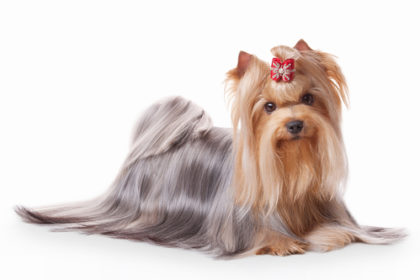
The short answer is that there isn’t any, at least not according to Nancy Simmons of the American Museum of Natural History. Both are made out of a protein compound called keratin, and are similar on a genetic level. That said, we keep coming across suggestions that there are differences, such as the site that states that the Yorkshire Terrier actually has hair, and not fur.
Some experts cite that the difference has to do with the length of a hair strand and its thickness. They say “fur” is typically recognized as “the relatively short hair with definitive growth that grows densely over the body.” Human hair is less differentiated than the hairs on other mammals, has the characteristics of both guard hairs and undercoat hairs (this according to a manual on hair microscopy published in 2004 by the FBI), tends to grow independently, and doesn’t stop growing.
Again, according to Ms. Simmons, there are different kinds of modified hairs to which we give different names, but they’re all still hair. Whiskers are hairs that work as sensory receptors (they are highly sensitive to movement and have nerves directly connected to a part of the brain and allow a dog to interpret it as sensory information. Even porcupines quills are simply greatly enlarged hairs.
Could it come down to semantics? Mindy Weisberger, Senior Writer for Live Science writes that individually, these keratinized filaments are called “hairs” and collectively, it’s called “fur.” Breeds with hair only have one single layer like the Yorkie, while breeds with fur may have two layers known as a double coat, or a topcoat and an undercoat. Perhaps the devil is in the details: Hair is generally smooth, longer, and finer than fur which is almost always shorter in length, denser than hair, and with more follicles per inch of the skin. Fur also goes through a faster growth cycle, and tend to shed more heavily.
And this brings us back to the Yorkie. Because the breed has one single layer of growth similar to humans, and grows continuously like a human’s, some refer to it as hair, and not fur. A puppy coat is quite different in softness and thickness than an adult coat, and it’s usually darker, as well. This tends to fade as the youngster grows into his adult coat.
Genetics calls the shots when it comes to that adult coat. A silk coat that is long, straight, and has an almost metallic sheen is a thing of beauty, but a Yorkie may also develop what’s called a wooly or wavy coat. This coat doesn’t brush out long and smooth like a silk coat, and it’s far more prone to mats. It generally doesn’t grow past a few inches, it’s often dark without the typical shine, and can almost look like it’s double-coated. Just imagine combed cotton wool.
Coat matters in this breed. The breed standard states that quality, texture and quantity of coat are of prime importance, and that hair (not fur) is glossy, fine and silky in texture. Its moderately long and perfectly straight (not wavy).
Pet or show ring, show us your Yorkies!

Great information!